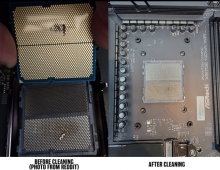
AMD Tests Memory Overclocking On Ryzen Systems
"What are the optimal memory settings for games?" Overclocker Sami Makinen took his ASUS Crosshair VI and AMD Ryzen 1700 CPU for a spin to find the fastest combination of settings in a few different tests.
AMD released its AGESA 1.0.0.6 update to Ryzen motherboard partners back in May and it resulted in a new wave of BIOS updates. AGESA 1.0.0.6 has a focus on new options for tweaking and overclocking memory.
The results of the tests were presented by AMD in a blog post. AMD analyzed:
- The impact of the new BankGroupSwap (BGS) BIOS option
- Single-rank DIMMs vs. dual-rank DIMMs
- Automatic sub-timings vs. manually-tweaked subtimings
- Max frequency vs. lower frequency at tighter timings
- Geardown Mode (GDM) on vs. off
GDM is enabled by default for memory speeds greater than DDR4-2667 per the DDR4 spec. GDM allows the RAM to use a clock that's one half the true DRAM frequency for the purposes of latching (storing a value) on the memory's command or address buses. AMD says that this conservative latching can potentially allow for higher clockspeeds, broader compatibility, and better stability - good for the average user.
For overclockers, Geardown Mode will be noteworthy because it also tells the memory subsystem to "disregard" the command rate set in the BIOS. AMD checked whether it's useful to run GDM if the desired memory clockspeed can be achieved: probably not.
The results indicate that Geardown Mode should be disabled for gaming if you can achieve your desired memory overclock with a 1T command rate. The opposite holds true if 1T CR proves too aggressive to reach your desired clockspeed--leaving Geardown Mode enabled may get you there. Finally, when it comes to GDM vs. 2T CR (not shown), specific memory throughput testing should be conducted as the balance of power will come down to your other memory timings.
BankGroupSwap (BGS) is a new memory mapping option in AGESA 1.0.0.6 that alters how applications get assigned to physical locations within the memory modules; the goal of this knob is to optimize how memory requests are executed after taking DRAM architecture and your memory timings into account. The theory goes that toggling this setting can shift the balance of performance in favor of either games or synthetic apps.
In AMD's tests, some games got a little faster with BGS off, while AIDA64 memory bandwidth was higher with BGS ON.
Lowering the timing values of memory (making them more aggressive) can yield better performance by shrinking the wait periods. However, timings that are too aggressive can easily lead to instability and memory corruption as the memory struggles to accurately read and write its own data.
Motherboards generally take on all the heavy lifting of setting the complicated list of memory timings through mechanisms like SPD and XMP. These timings are configured to balance the fussy triangle of performance, compatibility, and stability.
AMD's tests showed that overclockers with the wherewithal to hand-tune their memory timings can extract notably better performance in some PC games.
Last, but not least, AMD set out to find whether it was tighter timings or higher clockspeeds that mattered most on the AMD Ryzen processor. Sami pushed this combination of hardware up to DDR4-3520, DDR4-3466 with tighter timings, and DDR4-3200 with the tightest timings that could be achieved while maintaining stability with Memtest.
The verdict: tighter timings won. DDR4-3200 with aggressive timing adjustments outperformed the looser timings needed to hit DDR4-3520, while 3466 clearly split the difference with the right balance of timings and frequency.
AMD's conclusions are summarized below:
- Dual rank DIMMs (yellow) offered the best performance amongst "set and forget" (light blue, orange, yellow) memory configured automatically by XMP profiles.
- But the increased overclocking headroom of single rank modules was more than enough to overpower the benefits of rank interleaving, so manually-tuned single rank DDR4-3200 and 3466 won the day (dark blue and green).
- But the increased overclocking headroom of single rank modules was more than enough to overpower the benefits of rank interleaving, so manually-tuned single rank DDR4-3200 and 3466 won the day (dark blue and green).
- BankGroupSwap should likely be disabled for users that want the best PC gaming performance. As always, test your specific use case.
- Chasing the highest possible clockspeed required timings so relaxed that real world performance suffered versus lower frequencies with tighter timings. This is a fine balance, however, so testing on your platform is always helpful.
- Geardown Mode should likely be disabled if your overclock is stable with a 1T command rate. As always, test your specific use case.





















